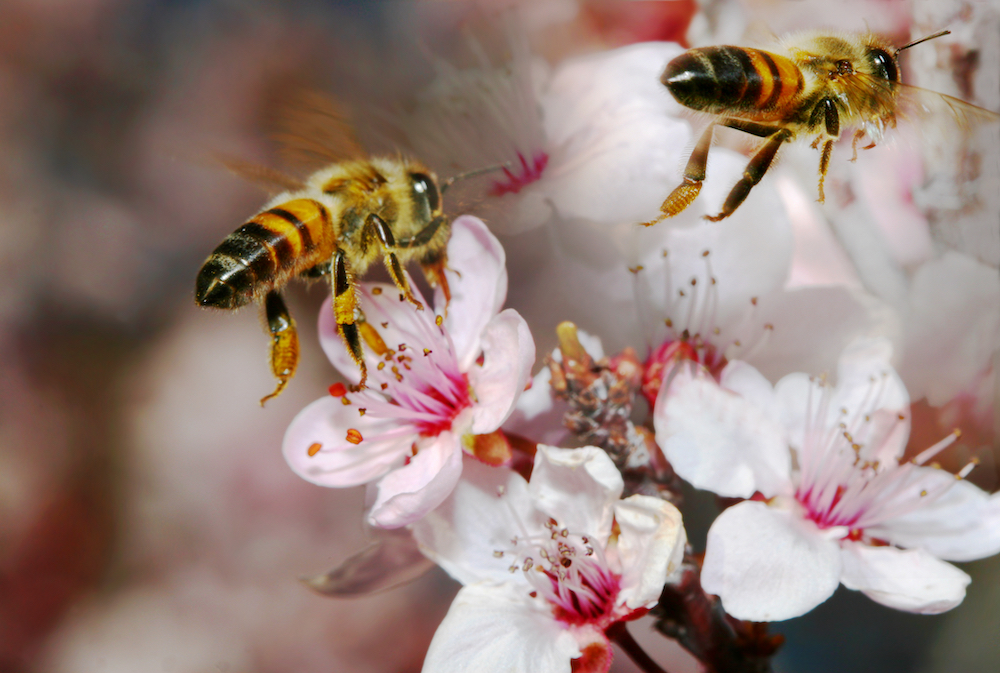Why Bees Make the Best Pollinators

Flowers rely on insects, birds and environmental forces to help them reproduce. During a process called pollination, pollen transfers from one flower to another flower of the same species, allowing them to produce seeds. Seeds will eventually grow into a new flower, beginning the process all over again.
Because most plants don’t have legs or any other means of spreading their pollen, they rely on other organisms called pollinators to do the work for them. Sometimes wind can also help in the pollination process.
While there are quite a few species who are considered pollinators, honey bees are one of the top pollinators. In fact, they are pretty much built for the job. They have certain physical characteristics and behaviors that make them perfect pollinators for flower species across the globe.
What makes honey bees such effective pollinators? In this article, we will highlight the special features of a honey bee and how these features aid in the pollination process.
What is pollination?
Simply put, pollination is the process of taking pollen from the male part of one flower to the female part of another flower. Through this process, the plant can produce seeds. As seeds develop, they will grow into a new plant.
Trees, shrubs and other plants rely on pollinators to aid them in the process and move pollen from flower to flower. Insects such as honey bees as well as hummingbirds, butterflies and bats are all pollinators. In most cases, pollinators don’t even know that they are helping plants reproduce. They are simply gathering food from a flower, and the pollen transfer happens as a result.
Honey bees have hair.
The bodies and legs of honey bees are covered in hair. While forager bees are gathering nectar from a flower, pollen naturally sticks to the hairs on their body. When the bee is ready to visit another flower, it unknowingly transfers pollen in the process. Without these hairs, pollination couldn’t happen in the way that it does.
Honey bees must forage for food.
Another key reason why bees make good pollinators is that they have to forage for nectar and pollen in order to survive. Bees use these two substances to create food for the hive, including honey. Without honey, colonies would be unable to survive winters when they are no longer able to forage. Honey provides them with the energy they need to stay warm during the cold winter months.
Honey bees are the perfect size.
The size and the shape of a honey bee makes them perfectly able to fit inside different kinds of flowers. No matter how big or how small the flower, honey bees can buzz right into the flower to remove the nectar with their proboscis and grab some pollen on the way.
There are different types of bees.
We talk a lot about honey bees here at D-Tek Live Bee Removal, but there are many other bee species that also aid in pollination. Trees and plants bloom at different times of the year. So, when honey bees have closed up shop for the winter, other bee species can take over the role. This means that all species of plants and flowers can rely on bees to help them reproduce.
Bees don’t charge for their services.
Fruit trees and other flowers can be manually pollinated through a variety of different processes that don’t involve bees. However, this can be extremely time-consuming and costly. Honey bees and other bee species can do the job for free all while gathering the nectar they need for survival.
Honey bees are considered a top pollinator because it seems that they were built for the job. Their size, structure and behavior mean that they must visit flowers to gather food and have the bodily features to easily transfer pollen from plant to plant. Without their work, plant species and many of the foods that we eat, would not be as widely available.
While there are a number of factors that impact the well-being of honey bee populations, including disease, varroa mites and temperature change among many other things, it is important that we do our part in protecting them. If you are confronted with a large honey bee hive or swarm, call a live bee removal company to perform a safe and humane removal service. Plant bee friendly plants in your garden. Forgo the use of any kind of chemicals that could put honey bees in danger.
D-Tek Live Bee Removal specializes in safe and humane bee removal in the San Diego area. If you are a San Diego resident or business owner who needs help removing a bee hive from your home or office, contact us today for your free and professional live bee removal quote.
